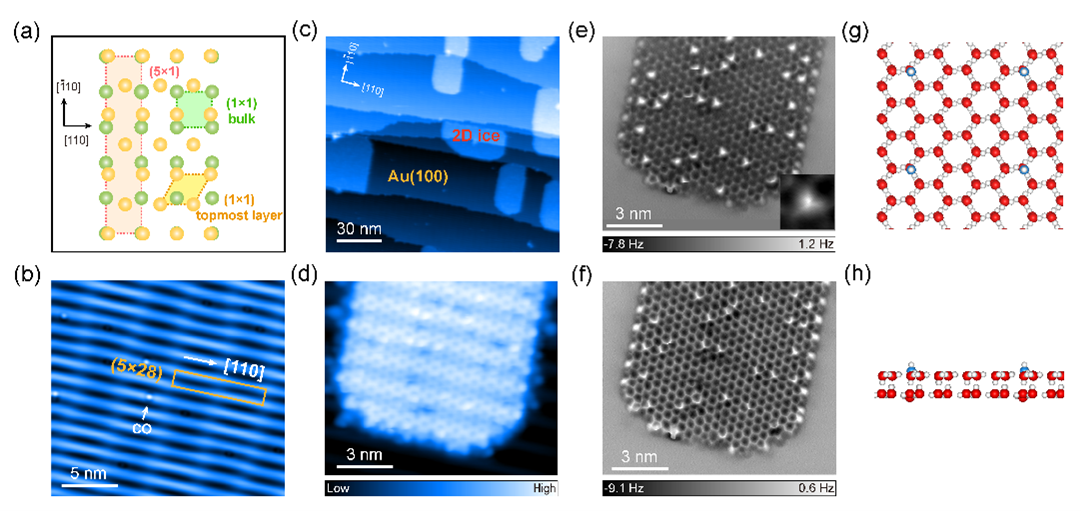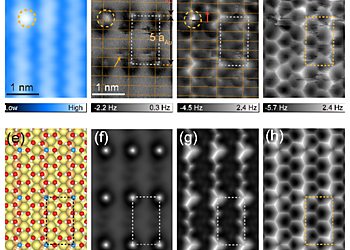Robustness of Bilayer Hexagonal Ice against Surface Symmetry and Corrugation
Result of the Month
Recently, qPlus-based non-contact atomic force microscopy (NCAFM) enables real-space imaging of interfacial water with superior resolution, such as discerning the O-H directionalities in a nearly noninvasive manner, identifying the atomic H-bonding skeleton, resolving the single ion hydrates and revealing the growth mechanism of a low-dimensional ice by probing the edge structures. In this Letter, using NCAFM in combination with density functional theory (DFT) calculations, we visualized the formation of hydrophobic BHI on both Au(110)-1 × 2 and Au(100)-5 × 28 surfaces, showing periodic 1D reconstruction with the spacing of 8.2 and 14.4 Å, respectively. Our findings indicate the robustness of BHI against the surface morphology and the degree of hydrophobicity.

(a) Overview STM image (set point: 300 mV, 5 pA) of buckled BHI on the Au(110)-1 × 2 surface. The yellow rhombus and rectangle represent the hexagonal and rectangle arrangements of bilayer ice, respectively. (b) Height dependent AFM imaging at tip heights of 320 pm (left), 270 pm (middle), 200 pm (right). (c) Simulated AFM images acquired at tip heights of 14.2 Å (left), 13.6 Å (middle), 13.1 Å (right). (d),(e) Top and side views of the calculated structure of buckled BHI. (f),(g) First layer (f) and second layer (g) structure. The black dash circles in (d),(e),(g) represent the H-up water molecules in the second layer. The yellow and black rectangles in (b)–(g) indicate the 3 × 2 unit cell.
STM and AFM experiments
All the experiments were carried out with an ultra-high vacuum Scienta Omicron POLAR-STM/AFM combined system operated at 4.8 K using a qPlus sensor equipped with a W tip (resonance frequency f0 = 24.7 kHz, spring constant k0 ≈ 1.8 kN m-1 , quality factor Q ≈ 43000).

(a) Schematic model of the reconstructed hexagonal array of the topmost layer (yellow spheres) on the bulk Au(100) surface with square symmetry (green spheres). (b) STM topography of reconstructed Au(100) surface, showing 5 × 28 reconstruction (set point: 100 mV, 50 pA). (c) Overview STM image of 2D ice on reconstructed Au(100) surface (set point: 1 V, 5 pA). (d)–(f) High resolution STM image (set point: 100 mV, 4 pA) (d) and height dependent AFM imaging at tip heights of 320 pm (e) and 290 pm (f). Inset of (e): close-up AFM image of a H-up water in second layer (size: 0.8 nm × 0.8 nm). (g),(h) Top and side views of the flat BHI model with isolated dangling OH (blue spheres).
---
AUTHORS:
Pu Yang1†, Chen Zhang1†, Wenyu Sun1, Jia Dong1, Duanyun Cao2,3*, Jing Guo1,5*, Ying Jiang4,5*
---
INSTITUTES:
1 College of Chemistry, Key Laboratory of Theoretical and Computational Photochemistry, Beijing Normal University, Beijing 100875, China
2 Beijing Key Laboratory of Environmental Science and Engineering, School of Materials Science and Engineering,Beijing Institute of Technology, Beijing 100081, China
3 Beijing Institute of Technology Chongqing Innovation Center, Chongqing 401120, China
4 International Center for Quantum Materials, School of Physics, Peking University, Beijing 100871, China
5 Interdisciplinary Institute of Light-Element Quantum Materials and Research Center for Light-Element Advanced Materials,Peking University, Beijing 100871, China
---
CORRESPONDING AUTHORS:
Duanyun Cao - dycao@bit.edu.cn
Jing Guo - jguo1294@bnu.edu.cn
Ying Jiang - yjiang@pku.edu.cn
---
JOURNAL AND LINK TO PUBLICATION:
Physical review letters: https://journals.aps.org/prl/
Publication: https://doi.org/10.1103/PhysRevLett.129.046001

